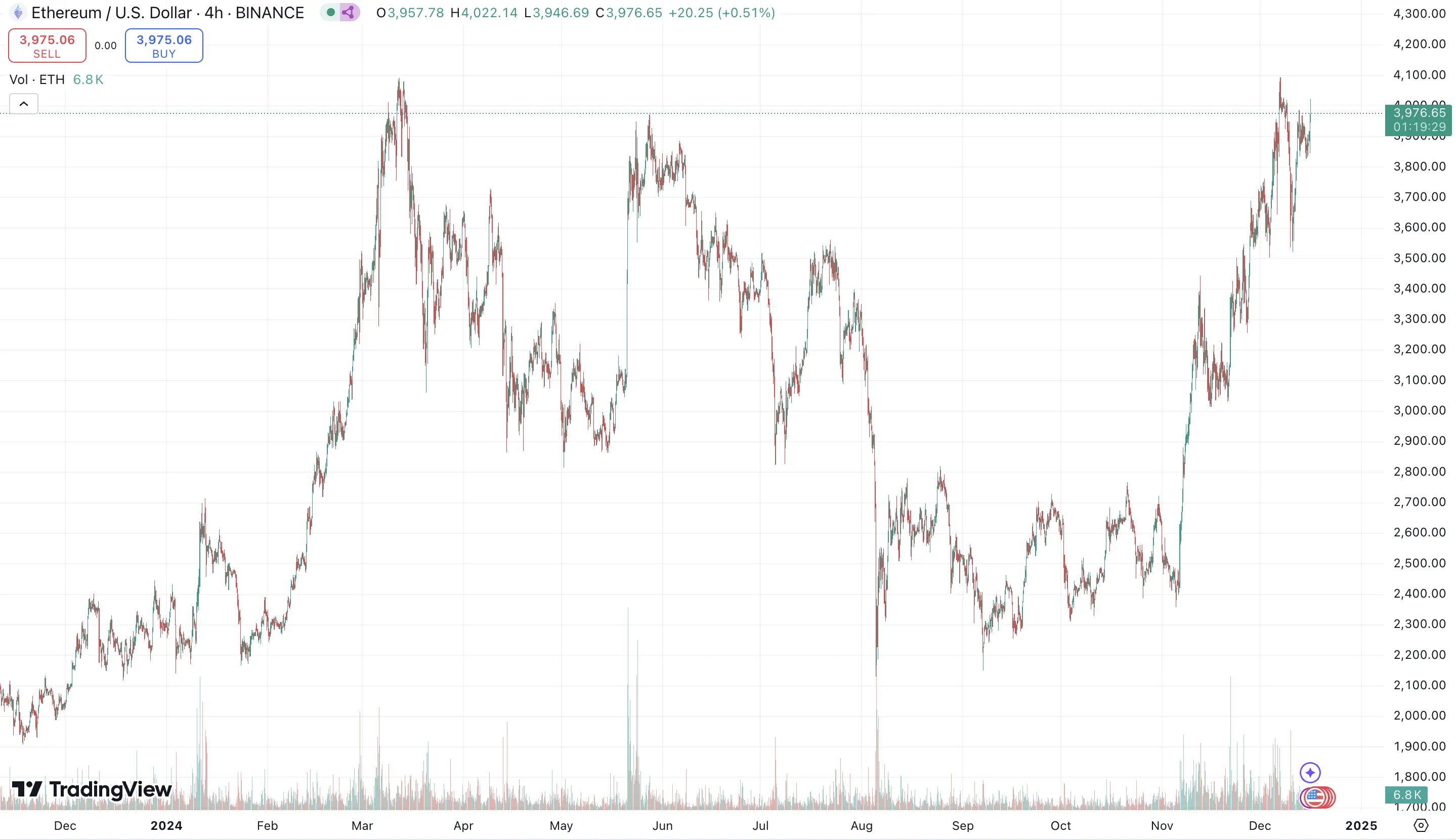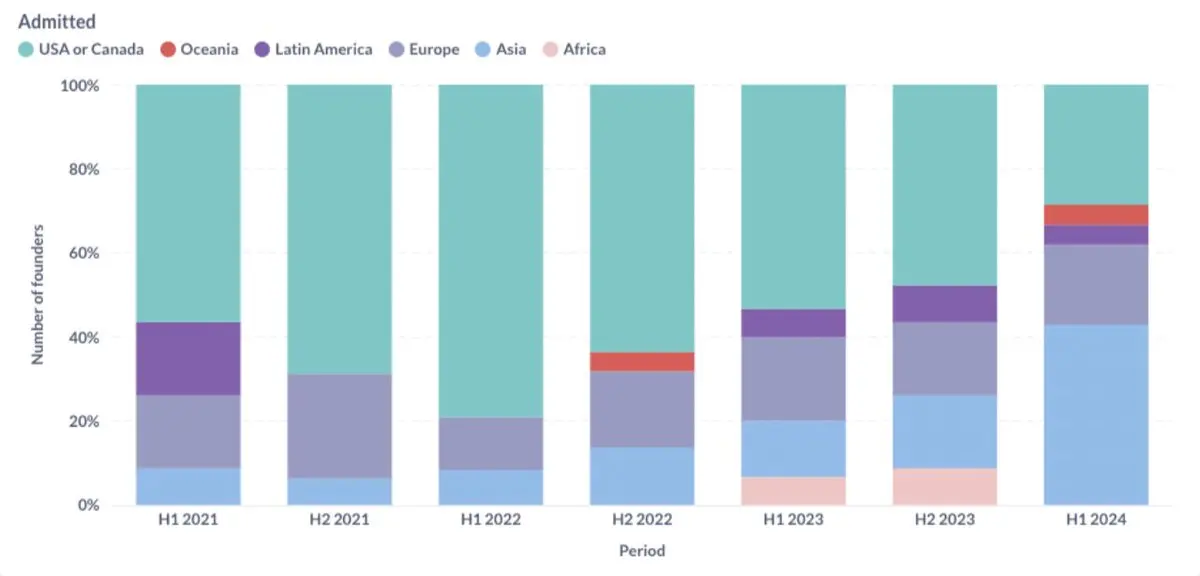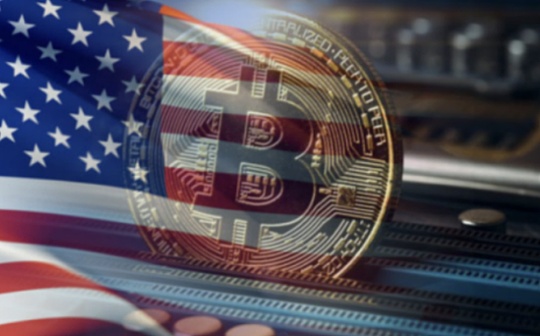Ethereum returns to $4,000, ecological fundamentals driving price?

Reprinted from panewslab
12/16/2024·6MAuthor: Kaori, BlockBeats
After the bull market correction phase in the past few days, the price of ETH once again stood at $3,900. Looking back on the development of Ethereum over the past year, there are many complex factors and emotions. On the one hand, the Cancun upgrade was successfully completed, the spot ETF was officially approved, and the technology and fundamentals have ushered in a new bull market; but on the other hand, as Bitcoin , SOL, and BNB have successively exceeded all-time highs, and the price of ETH is still hovering at the $4,000 mark.

As can be seen from the price chart of ETH this year above, Ethereum has experienced three main stages this year, and the increases in the three stages correspond to different reasons. At the beginning of the year, the Bitcoin spot ETF was approved, and the price of Ethereum followed market sentiment higher, once exceeding $4,100, but at the end of March, it also began to fall along with the broader market. And because of the strong surge in SOL and its ecosystem, the Ethereum ecosystem is facing a massive exodus of liquidity.
In May, the Ethereum spot ETF was approved and the price briefly surged, but its demand was not as strong as Bitcoin. The initial market reaction to the launch of the Ethereum ETF was negative, as speculative investors who purchased the Grayscale Ethereum Trust in anticipation of its conversion to an ETF took profits, resulting in $1 billion in outflows, bringing downside to the Ethereum price pressure. In addition, ETH's narrative of being biased towards technological innovation products is less likely to impress the traditional market than BTC's "digital gold", and the SEC's prohibition on Ethereum spot ETFs from participating in the pledge function has objectively weakened its appeal.
After that, disputes over the Ethereum Foundation, the re-staking ecosystem, and the roadmap ensued, and Ethereum ushered in a dark moment.
In November, the dust of the US election settled. The pro-crypto Republicans and Trump brought stronger confidence and liquidity injections to the entire crypto ecosystem, and Ethereum ushered in its third wave of gains this year. This time the rise is different from the past. Institutions have entered the market with a clear name and the fundamentals of liquidity have improved. This market is using funds to tell us what institutions recognize and are optimistic about. Ethereum is also destined to continue its "world computer" ” original intention.
Improved liquidity fundamentals
Since December, Ethereum spot ETFs have seen net inflows of over US$2.2 billion for half a month. Nate Geraci, president of The ETF Store, said on social platforms that advisors and institutional investors have just begun to pay attention to this area.
In the third quarter of this year, banks such as Morgan Stanley, JPMorgan Chase and Goldman Sachs significantly increased their holdings in Bitcoin ETFs, almost doubling their holdings quarter-on-quarter, but their investment scope is not limited to Bitcoin, according to the latest 13F filings , these institutions have also started buying Ethereum spot ETFs since then.
In addition, the Wisconsin Investment Commission and the Michigan Retirement System purchased Bitcoin spot ETFs in the first two quarters, and Michigan further purchased Ethereum spot ETFs worth more than $13 million in the third quarter. This shows that pension funds, which symbolize low risk appetite and long-term investment, not only recognize Bitcoin’s role as a digital value store, but also value the growth potential of Ethereum.
When the Ethereum spot ETF was passed, JPMorgan Chase pointed out in a report that demand for the Ethereum spot ETF would be much lower than that of the Bitcoin spot ETF. However, the report predicted that the spot Ethereum ETF would attract as much as $3 billion in net investment during the rest of this year. Inflows, if staking is allowed, this number could be as high as $6 billion.
Jay Jacobs, head of U.S. thematic and active ETFs at BlackRock, said at the "ETFs in Depth" conference, "Our current exploration of Bitcoin, especially Ethereum, is only the tip of the iceberg, and only a very small number of clients hold it (IBIT and ETHA). ), so our current focus is on that rather than launching new altcoin ETFs.
In a Blockworks Research survey report, the vast majority (69.2%) of respondents currently hold ETH, with 78.8% being investment firms or asset managers, indicating that driven by revenue generation and cybersecurity contributions, Institutional willingness to participate in ETH staking has reached critical mass.
Institutions are actively participating in ETH staking, but the level of participation and methods vary. Regulatory uncertainty has led to different attitudes from all parties, with some institutions proceeding cautiously while others are less worried, and institutional participants are concerned about the risks related to ETH staking. High awareness of the operational aspects and risks associated with staking.
The tide turns
Since the FTX scandal, Coinbase, Kraken, Ripple, etc. have been severely cracked down by U.S. regulatory agencies such as the SEC. Many crypto projects cannot even open accounts in mainstream U.S. banks. Traditional financial institutional investors who entered the market due to DeFi in the last bull market also suffered huge losses. Large funds such as Toma Bravo, Silver Lake, Tiger, and Cotu not only suffered setbacks on FTX, they also invested at high valuations. A number of crypto projects have failed to deliver on their grand promises, and the funds have yet to flow back.
In the second half of 2022, many DeFi projects were forced to relocate outside the United States. According to Alliance DAO Lianchuangqw, “Two years ago, about 80% of crypto startups that met the standards were located in the United States. However, this proportion has increased since then. It has continued to decline since then and is currently only about 20%.”

But on November 6, Trump won the election, and the green light the U.S. financial system had been waiting for came on.
Trump Saves the Cryptocurrency Circle
Trump's victory will undoubtedly clear regulatory doubts about institutional adoption.
Established the Department of Government Efficiency and directly brought together a series of Wall Street financial elites such as Musk, Pete Thiel, and Marc Andreessen under its command. After appointing Paul Atkins as SEC Chairman, Trump also appointed PayPal Lianchuang David Sacks serves as "White House Director of Artificial Intelligence and Cryptocurrency Affairs." A series of measures show that Trump will create a government with loose encryption regulations.

JPMorgan analysts said that several stalled cryptocurrency bills after Trump took office may be quickly approved, including the Financial Innovation and Technology Act of the 21st Century (FIT21), which clarifies the regulatory responsibilities of the SEC and CFTC. Could provide much-needed regulatory clarity to the crypto industry. He also said that as the regulatory framework becomes clearer, the SEC's strategy of increasing enforcement efforts may evolve into a more collaborative approach, and its Staff Accounting Bulletin No. 121 (SAB 121) restricting banks from holding digital assets may will be abolished.
And high-profile lawsuits against companies like Coinbase may also be mitigated, settled or even dropped. Regulatory notices to companies like Robinhood and Uniswap could be reconsidered, reducing litigation risk for the broader crypto industry,
In addition to department and bill reforms, the Trump team is also considering slashing, merging or even eliminating the main bank regulators in Washington. Trump advisers asked some Department of Government Effectiveness staff about whether the Federal Deposit Insurance Corporation (FDIC) could be abolished during interviews with potential bank regulators, people familiar with the matter said. Trump advisers also inquired about potential candidates for the Federal Deposit Insurance Corporation and the Office of the Comptroller of the Currency. It also proposed plans to merge or overhaul the Federal Deposit Insurance Corporation, the Office of the Comptroller of the Currency and the Federal Reserve.
As policy dividends are gradually released, larger institutional funds in the U.S. market are expected to return to the crypto market.
The DeFi renaissance is underway
More stable capital such as family offices, endowments, and pension plans will not only deploy Ethereum spot ETFs, but will also once again enter the DeFi field that has been verified in the previous cycle.
Compared with 2021, the total supply of stablecoins has reached its highest level. In the more than a month after Trump won the election, the total supply of stablecoins has been increased by nearly 25 billion U.S. dollars. The current total market value of stablecoins reaches $202.2 billion.

As the leader of U.S. crypto-listed companies, Coinbase has made achievements in the DeFi field this year in addition to its political contributions. On the one hand, it is the largest crypto ETF custodian, and on the other hand, it launched cbBTC.
Since cbBTC faces the same custody and counterparty risks as most Bitcoin ETFs, some traditional financial institutions may re-evaluate whether to continue paying fees to hold Bitcoin ETFs and switch to participating in the DeFi ecosystem at almost zero cost. This shift could bring capital inflows to market-tested DeFi protocols, especially as the yields offered by DeFi are more attractive than traditional finance.
Another major DeFi sector in this cycle is RWA. In March this year, BlackRock cooperated with the U.S. tokenization platform Securitize to issue the tokenization fund BUIDL (BlackRock USD Institutional Digital Liquidity Fund), officially entering the market in a quite high-profile manner. RWA track. Capital giants such as Apollo and Blackstone, which control huge capital pools, are also beginning to prepare to enter this market and bring in a large amount of liquidity.
After the Trump family launched the DeFi project, compliant DeFi has been a hotly discussed topic. Ethereum's established blue-chip DeFi projects such as Uniswap, Aave, and Lido immediately responded to their prices after Trump won the election, and all rose and broke through, while rising stars in the DeFi sector such as COW, ENA, and ONDO also reached new highs one after another.

At the same time, Trump’s encrypted DeFi project WLFI has also been trading Ethereum tokens very frequently recently. After exchanging 5 million USDC for 1,325 ETH in multiple transactions, its multi-signature address bought another 10 million US dollars each. ETH, $1 million LINK and $1 million AAVE. There have been recent reports of giant whales increasing their holdings of ETH, suggesting that both institutions and whale accounts are returning to the Ethereum ecosystem.

WLFI multi-signature address position information
It goes without saying that the recent performance of new and old projects in the DeFi track at the price level is currently about 100 billion US dollars in TVL, and the current total value of cryptocurrencies and related assets is about 4 trillion US dollars, among which the real active players in DeFi Funding in the field accounts for only 2%, which is still small compared to the size of the entire cryptocurrency market. This means that DeFi still has huge room for growth as regulatory trends change.
Aave is a typical beneficiary of this round of "fund reflow". Its price had broken through before Trump won the election. Since then, TVL and revenue have shown explosive growth: TVL exceeded the historical high in October 2021 and reached US$22 billion; The currency price has been rising from the year's low of 80 USDT, breaking through the March high of 140 USDT in early September and accelerating its rise in late November; the protocol's total single-day revenue exceeded September 2021 At the second peak of the month, weekly income hit a record high.
Although Aave has recently upgraded to V4, the innovation power at the technical level may not be enough to support such a large-scale increase. The promotion at the regulatory and financial levels is obviously the more important logic, and even this promotion will overflow into the previous cycle. The NFT track is also favored by institutions.
The future of Ethereum
Ethereum encountered a series of controversies and discussions related to ecological development in the middle of this year. With the rise of Solana, new and old public chains began to capture Ethereum’s developer and user base, and the ecosystem began to shake. Ethereum seemed to have forgotten its original goal. As the first blockchain to create smart contracts, Ethereum used its first-mover advantage to successfully get major institutional investors to pay for it in the last cycle. Whether it is DeFi, chain games, NFTs, or the Metaverse, there is no escape from Ethereum. Fang Ecology, its original intention of "World Computer" has been deeply rooted in the hearts of the people.
Although Ethereum's liquidity fundamentals are currently improving optimistically, from the perspective of Ethereum itself, its average daily transaction number, gas fees, number of active addresses and other data indicators on various chains have not increased significantly. This shows that the activity on the Ethereum chain has not increased simultaneously with its price, and the block space is still excessive.

Ethereum Gas Fee Level
In the past few years, Ethereum has focused on building cryptocurrency infrastructure, providing the market with a large amount of cheap block space. On the one hand, this move improves Dapp's access performance to blocks and reduces the transaction costs of L2 expansion solutions. On the other hand, due to insufficient market liquidity and sluggish transaction demand, Ethereum's huge block space has not been fully utilized. .
However, this is not really a problem in the long term. As mentioned above, institutional funds are gradually returning and even starting to create exclusive blockchain use cases. For Ethereum, which has a secure and flexible architecture, to B is its advantage. Not only does it have overwhelming advantages in security, it is also compatible with many EVM projects, providing developers with an option that is almost "impossible to get fired."
Ethereum’s long-term value will depend on the scarcity of its block resources, that is, the world’s actual, ongoing demand for Ethereum block settlement. As institutions and applications continue to pour in, this scarcity will become increasingly prominent, thus laying a stronger value foundation for Ethereum. Ethereum is the world computer of an institution. Starting with DeFi, institutions will solve the problems of excess Ethereum blocks and roadmap disputes in the future.
In early December, Ethereum researcher Jon Charbonneau wrote a long article analyzing why Ethereum needs a clearer "North Star" goal. He also suggested that Ethereum's ecological power should be concentrated on the "world computer", just like Bitcoin. Bitcoin’s “digital gold” and Solana’s “on-chain Nasdaq”.
Ten years have passed, and Ethereum is no longer in its entrepreneurial stage. In the next decade, Ethereum’s future is clearly visible.


 jinse
jinse